Themes > Features
02.11.1999
World Trade : Who Matters at Seattle
It took eight years,
between 1986 and 1994, for GATT member countries to arrive at a world
trade agreement through the negotiations which began at Punta del Este,
Uruguay. Even in April 1994 the negotiations were by no means complete, as
reflected in the pre-decided, post-round negotiations on
telecommunications, information technology and financial services. It was
also reflected in the Uruguay Round decision to go in for a review and
renegotiation of the agreements relating to the contentious areas of
agriculture and services in the year 2000. The Seattle ministerial meet
scheduled for end November was significant because it was meant to arrive
at an agenda for these continuing negotiations.
In the run up to
Seattle, however, different sections of the developed, industrial
bloc have, for quite different reasons and with significantly different
agendas, mooted the idea of a more comprehensive Millenium round. Revising
the 'review and renegotiation' timetable into a full-fledged new round
does have important implications. To start with, it implies that the
fundamental thrust of the next set of negotiations should be further
liberalisation in chosen areas, with no review and roll back of past
agreements. Secondly, it signals to the world that what is at stake are
not marginal adjustments around Uruguay Round benchmarks, but significant
advances in the direction of further liberalisation. Third, it opens the
door to the introduction of new areas of negotiation such as trade and
environment linkages, trade and social clause linkages and finally a
multilateral agreement on investment.
For the
developing countries, the answer to the question as to whether we need a
new round just now depends on an assessment of the first of these
implications. Its been only five years since the Uruguay round treaty and
the new implementation framework centred around the WTO has been in place.
And during those years there is little indication that the wholly unequal
world trading order has changed significantly.
As Chart 1 shows, the annual average rate of growth of developing country
exports has fallen by a percentage point between the four year pre-UR
period (1991-94) and the period 1995-98, whereas it has risen
significantly for the developed countries. If we consider two groups
consisting of the OECD and non-OECD countries, the share of the latter has
actually improved slightly, indicating that it is some of the more dynamic
of the developing countries (which have joined the OECD) that have lost
out in the years after the Uruguay Round.


Finally Chart 3 indicates that while, the prices of manufactured exports from the OECD countries have fluctuated around a stable level during 1991-98, the prices of the principal exports of most developing countries, viz., agricultural raw materials and minerals, ores and metals, which appeared to be buoyant between 1993 and 1995, have since registered a sharp fall. The only commodity group for which prices have risen and stayed high is food and beverages, in whose case a significant part of the surpluses are with the developed countries. Not surprisingly, current account deficits have tended to widen in the case of many developing countries.

It must be noted that this relatively poorer trading performance of the developing countries is not because they are not "rule-savvy" and have not exploited the loopholes available within the UR framework to erect new non-tariff barriers to imports. One such barrier would be the device of resorting to import restrictions in the name of dumping. In recent times, both the number of cases and countries resorting to such actions have increased substantially. In the name of market disruption or distress caused by imports, whether valid or not, countries have increasingly invoked anti-dumping relief rather than resorted to safeguard action under article XIX of GATT. Interestingly, it was the developing country group which substantially upped its use of anti-dumping initiatives. As Chart 10 shows, while the number of anti-dumping initiations have fallen from 678 to 394 in the case of the developed countries, it in fact rose from 353 to 509 in the case of the developing countries between 1991-94 and 1995-98. The failure, despite this effort, to realise the promise of a significantly improved position for developing countries in the world market after the Uruguay Round can be traced to the structurally inadequate gains achieved by developing countries in the form of improved market access.

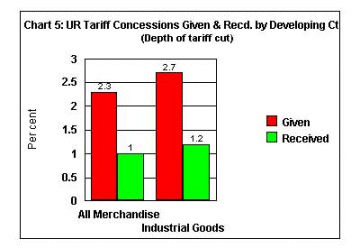

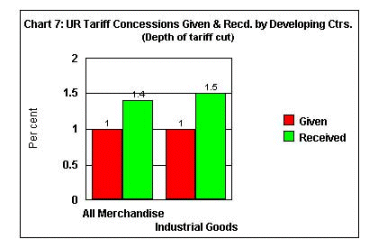
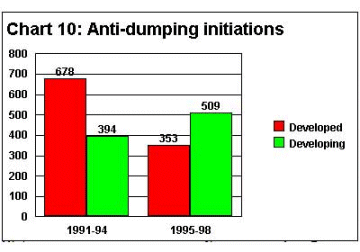
As Charts 4 and 6 and 5 and 7 respectively show, the concessions received
by developing countries in terms of the share of imports over which tariff
concessions apply and the depth of the tariff cut they benefited from was
lower than that which applied to the developed countries. That is,
starting from a position of subordination, developing countries appeared
to have offered more in the nature of concessions with regard to market
access than the developed countries did. But even this picture is partial,
in as much as it does not capture the commodity composition of the areas
in which the concessions were offered by the two sides. In fact, the
evidence is now overwhelming that both across and within product groups,
the developing countries began to give virtually immediately after the
Uruguay round
negotiations were complete, but they are yet to begin to receive much by
way of benefits in areas which matter to them from an export point of
view.
Nothing epitomises this more than the agreement relating to textiles. From
the point of view of the developing countries, the most visible and
"multilaterally" accepted non-tariff barrier arrangement prior to the
Uruguay Round was the Multi-Fibre Arrangement. That arrangement was the
end-result of a series of negotiated agreements starting in the 1960s, all
of which sought to provide the developed countries with the time needed to
restructure their industries so that competitive textile exports from
lower-cost developing countries do not "disrupt" their markets. Despite
three decades of agreement on that principle and periodic revisions of the
deadline for ending import restrictions, textiles still were by the
late-1980s not permitted free entry in developed-country markets. The case
for an immediate end to such restrictions, under a new multilateral trade
regime was therefore strong. However, though the Uruguay Round agreement
on textiles and clothing provided for the phasing out of restraints
stemming from the Multi-fibre Arrangement, it once again delayed the
process of liberalisation. The process was designed to occur in four
stages over a ten-year period and is heavily "back-loaded", in the sense
that most of the liberalisation occurs during the last stages. The four
stages defined involve the following:
-
In the first stage, beginning on the date on which the Uruguay Round became effective, each signatory nation was required to remove quotas only on products that account for 16 per cent of its total volume of imports of four categories of textiles and clothing in 1990 (tops and yarns, fabrics, made-up textiles products and clothing);
-
In the second stage, beginning three years and one month after the agreement came into force, quotas were to be removed on a further 17 per cent of the total volume of 1990 imports; In the third stage, which begins four years later, quotas are to be removed on products that account for not less than 18 per cent of the total volume of 1990 imports;
-
Finally, after 10 years and one month, all other quota restrictions are to be eliminated.
This prolonged and back-loaded agreement in a labour-intensive area in which the developed countries had agreed to open up markets more than three decades back, points both to the relative positions of power of developed and developing countries in the Uruguay Round negotiations as well as to the extent of commitment of the latter to offer greater market access as a quid pro quo for the rapid liberalisation of trade and investment rules in the developing countries. What is more revealing is the evidence on the progress on this front. With two stages of the phase out process being complete, 33 per cent of imports by volume of four categories of textiles and clothing are ostensibly outside any quota regime.
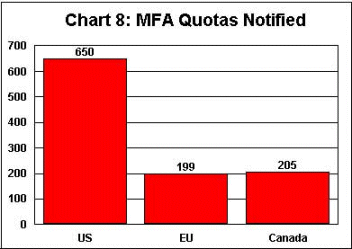

However, out of the quotas under MFA notified by the US, EU and Canada (Chart 8), after the completion of the second stage of implementation of the MFA phase out, only 1, 7 and 14 per cent respectively (Chart 9) have been withdrawn. Much of the phase out thus far covered commodities which were not even in consideration. Further, most of these are textile products which do not dominate the developing countries' export basket. Above all, as Charts 11 and 12 indicate, the extent of tariff concessions, both in terms of tariff reduction and the share of the relevant imports subject to cuts, provided by the developing countries have been higher than that provided by the developed in industrial products in general and in the textile area in particular. That is, five years after the completion of the Round and at a time when talk is already on with regard to initiating a new round, developing-country, market-access "gains" in an area most crucial to them have been minimal.

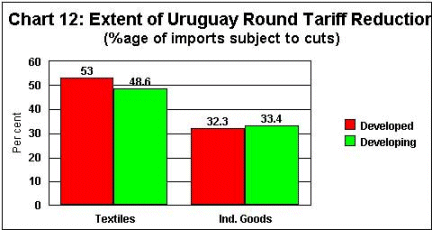
The implication of this is obvious enough. Even in an area as basic as
market access, what is called for now is a review of the Uruguay Round
aimed at redressing the inequalities it carried through in its fine print
rather than an extension of the Round either in the form of more intensive
liberalisation or in the form of extending the multilateral framework into
new areas. However, neither the outcome of the Uruguay Round nor the
current discussion is influenced by the interests of the developing
countries. The perception that the Marrakech agreement of 1994 constituted
a qualitative advance sprang from many sources. To start with, it created
a formal international institutional framework in the form of the World
Trade Organisation, to oversee the implementation of the terms of the
agreement. This was expected to correct the inadequacy that there was no
formal institutional framework governing world trade, especially because
the agreement included clauses aimed at strengthening dispute settlement
mechanisms and disciplinary norms regarding the use of safeguard measures
like anti-dumping and countervailing duties which can be used to sidestep
uncomfortable trade liberalisation policies.
Secondly, the Uruguay Round went beyond intensifying past efforts at
reducing the barriers to trade, by extending GATT disciplines to a range
of "sensitive" commodities, like agricultural goods, textiles and apparel,
which had hitherto not been subject to the same discipline that applied to
the trade in most manufactures. Finally, the Uruguay Round touched on a
range of new issues such as trade in services, trade-related intellectual
property measures (TRIPs) and trade-related investment measures (TRIMs).
Of these "advances" it is the second set in which the results have been
particularly disappointing. The virtual standstill in textiles has already
been referred to. And in agriculture, even a commentator like trade
economist T.N. Srinivasan, who shares the free-trading bent of the WTO,
argues that: "Other than bringing agricultural trade under the discipline
of GATT rules, there is very little liberalisation. (And even in
agricultural trade coming under GATT rules, there are some exceptions.
Whereas the subsidisation of exports of manufactures is ruled out,
agricultural export subsidies are merely to be reduced but not eliminated,
let alone outlawed.) ... Although the reduction of export subsidies and
domestic support measures will be of benefit to developing-country
exporters, the possible rise in world prices of foodgrains with the
reduction in subsidised exports from developed countries will hurt
food-importing developing countries ... on balance, agricultural
liberalisation is likely to be a washout from the perspective of
developing countries." (Developing Countries and the Multilateral Trading
System: From the GATT to the Uruguay Round and the Future, Colarado:
Westview Press, 1998).
The third area of expected advance has indeed proved to be an area of
substantial loss from the point of view of the developing countries,
inasmuch as it constrains their efforts at enhancing and widening that
competitive advantage, where the limitations are more severe. This impact
is principally mediated through the agreement on Trade Related
Intellectual Property Rights (TRIPs), which defines those rights and the
mechanisms for enforcing them and for dispute settlement by WTO. That
agreement has required members to introduce legislation which provides a
sovereign guarantee that the patent rights of corporations, wherever
acquired and whether relating to products or processes, would be
protected. Such patent protection for products and processes is to apply
for a period of 20 years in almost all fields of technology. Patent
protection for products is especially significant in the chemical and
drugs and pharmaceuticals industries, where many developing countries had
found alternative processes to replicate products once standardised. But
they are proving particularly controversial in areas involving traditional
knowledge and life forms. The TRIPs agreement also limits efforts to
replicate industrial designs, such as the lay-out designs of integrated
circuits. Given the "technological gap" between the developed and
developing countries and the concentration of both existing patents and
R&D expenditure in the latter, this would be a major constraint on the
export competitiveness of domestic firms. This factor, along with the
agreement on Trade Related Investment Measures (TRIMs), which forecloses
governmental efforts to force a degree of indigenisation and domestic
linkage on international producers being provided freer access to
developing country markets, substantially increases the dependence of
developing countries on foreign firms as the medium to win and sustain
their foothold in international markets.
Overall, there are five aspects which call for attention when examining
the gains to developing countries from the implementation of the Uruguay
Round proposals: first, gains from increased access to foreign markets
have been small and partly neutralised by greater international
competition in domestic markets; second, tariff benefits have been
outweighed by non-tariff barriers in areas where developing countries have
obvious competitive advantages, as is true of labour-intensive sectors
where wage costs are an important part of total costs; third, in areas
like textiles where developing countries already have a strong
international presence, the full benefits of the Round are yet come and
would come slowly; fourth, the dependence on transnational firm strategies
and the costs and the extent of industrial restructuring would be higher
in the wake of the TRIPs agreement, necessitating special strategies in
the more-developed developing countries to enhance their technological
capabilities based on greater R&D efforts; finally, developing countries
would be increasingly hard put to follow conventional "mercantilist"
policies like the provision of export subsidies.
In the event, this discussion and the recent trade experience of
developing countries suggests that expectations that the new world trading
arrangement will in itself bring substantial static and dynamic gains to
the developing countries were grossly exaggerated. The developed countries
arrived at a compromise in which the US and EU retained protection of
their agriculture as well as sensitive labour-intensive sectors, while
winning for themselves greater access into developing country markets for
telecommunications, information technology and financial and other
services. This has in practice only perpetrated the inequality
characterising the world trading system.
Despite this experience, the developed countries have chosen to push for a
new round of trade negotiations at
Seattle.
Most developing countries are sceptical about the motivations of the
developed countries. The scepticism stems in part from the unwillingness
of the developed countries to agree to a review of the fall-out of the
Uruguay Round before proceeding further down the road of selectively
opening up trade. But more crucially it is also related to the two issues
which are expected to dominate the discussions: first, the linkage between
trade and environmental concerns; and second, the proposal to incorporate
a social clause in the trade agreement. The testimony of Ambassador
Richard Fisher, Deputy United States Trade Representative, to the Trade
Subcommittee of the Senate Committee on Finance on July 14, 1999 is
revealing. Elaborating on the Clinton Administration's trade agenda, which
will have at its centre a new accelerated negotiating Round for the 21st
century, he included among the initiatives to be taken up by the US the
following:
-
Addressing the intersection between trade and environmental policies. Trade and environmental policy need to be mutually supportive. As trade promotes growth domestically and overseas, we must at the same time ensure clean air, clean water and protection of our natural resources, as well as effective approaches to broader questions like conservation of biodiversity.
-
Addressing the intersection between trade and labour. Again, as in our domestic economy, growth can and should be accompanied by safer workplaces and respect for core labour standards. There is room for the WTO to collaborate with the International Labour Organisation on some of these issues. As the President has announced, the Administration is requesting $35 million in FY 2000 for a new multilateral program in the ILO to provide technical assistance for international labour rights initiatives, such as eliminating exploitive child labour, and for our own Department of Labour to help our trading partners strengthen labour law enforcement. These and other such efforts should be a focus of renewed co-operation with the ILO.
To quote free-trade enthusiast T. N. Srinivasan once again: "the most serious external threat to developing countries in the post-Uruguay Round world trading order is from the attempts to link their market access to performance in non-trade related areas such as protection of the environment and labour standards. The pernicious notion that a country with lower environmental and labour standards, when it exports its products to another with higher standards, is engaged in eco-dumping and is in unfair competition has gained ground... diversity in labour and environmental standards (at least as far as purely domestic environmental insults are concerned) is legitimate, No country should be coerced to set those standards at levels that are not sustainable given its stage of development. There is also the danger that the movement in the developed countries genuinely concerned about environmental degradation and interested in the improvement of labour standards in poor countries will be captured by those who wish to use it for their own crass protectionist purposes. It is clear that if the developed countries are not willing to compensate poor countries for raising their standards beyond what they could sustain on their own but coerce them through denial of access to their own markets, the liberalisation of market access in the post-UR world will have no meaning for poor countries." These and the arguments delineated earlier, provide strong reasons to struggle for an agenda of "standstill, review and roll-back". But as in the case of the Uruguay Round the interests of the developing countries are unlikely to influence the decision whether negotiations should begin or what should be their agenda.
© MACROSCAN 1999